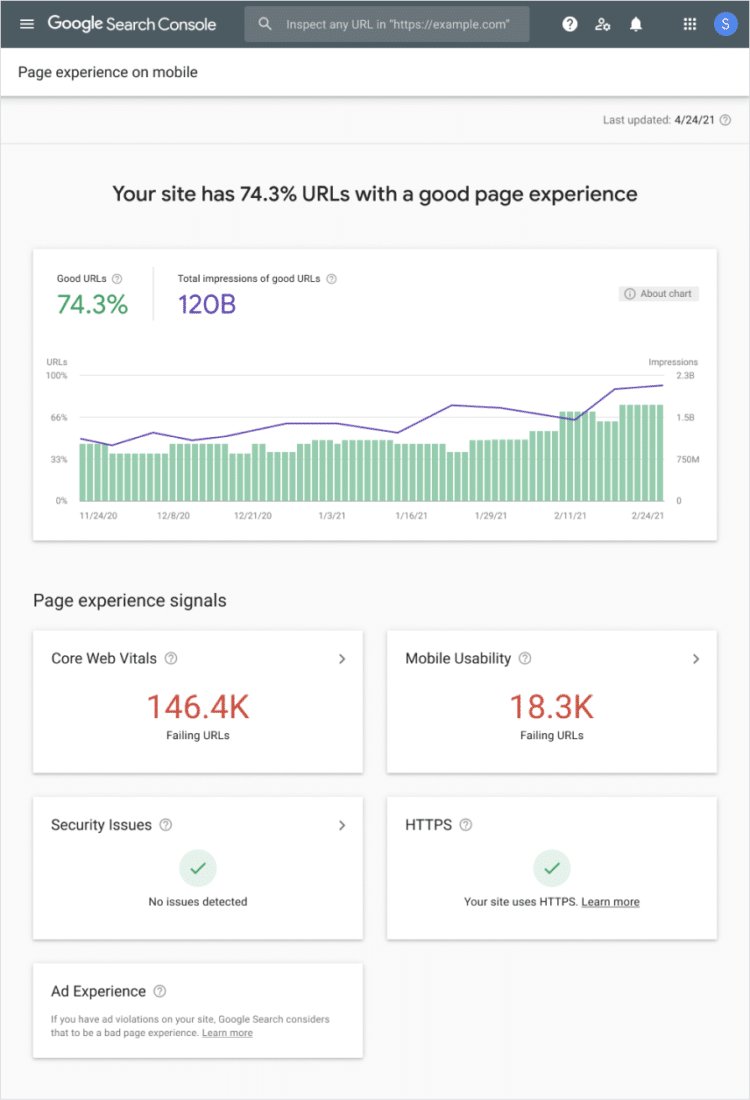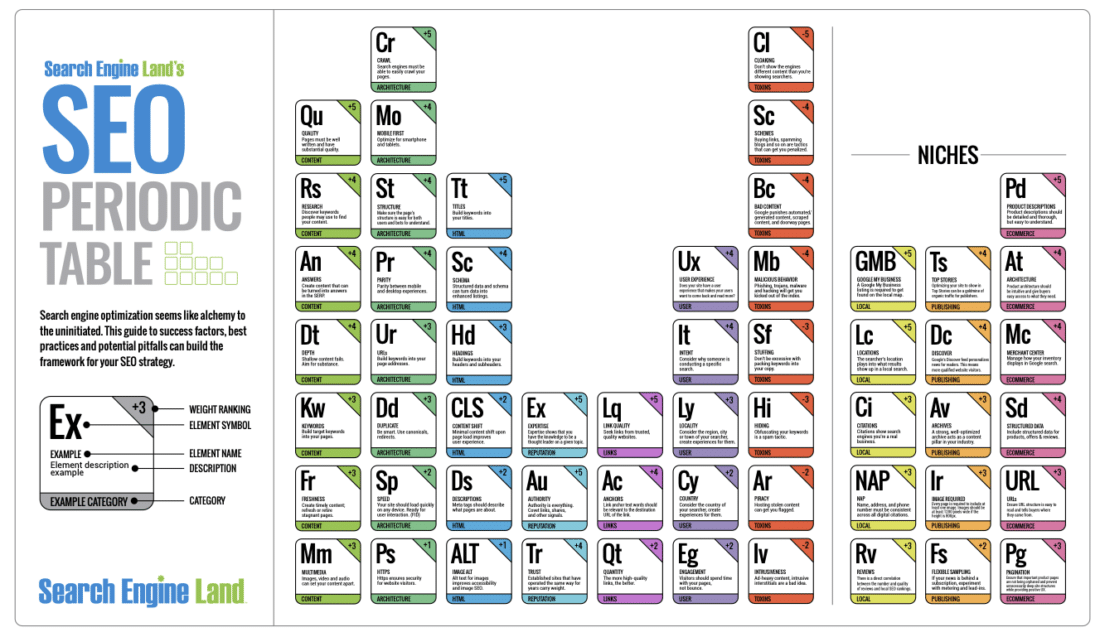Search engine optimization (SEO) is the process of being discovered and getting traffic through organic search engine results pages. Organic search is the dominant source of trackable web traffic and is also the largest channel of revenue for websites. Search plays a major role in attracting customers at the top of the funnel during their initial discovery process. It also creates awareness of your brand. Websites that build up their domain rating with superior technical SEO benefit from higher organic search rankings. If you’re just starting out, here’s a helpful beginner’s primer to SEO.
There are two different types of traffic from search engines: organic and paid. Paid is advertising (pay per click) and is featured at the top and/or bottom of a search results page. Organic refers to the results found in the middle of the page, which are unpaid. Earning the coveted top spots on a search page is accomplished through SEO.

Below are the different pieces of your SEO strategy and how to optimize each to create a solid organic search plan.
On-Site (aka On-Page) SEO
There are two major things that affect your website ranking: authority and relevance. A website’s authority is considered “off-site SEO,” or which of your links are mentioned on other websites. A website’s relevance is “on-site SEO,” referring to the keywords and key phrases on your own website.
How does a website prime itself for great on-site SEO? Your website should be intuitive and enjoyable to use; should meet the needs of your customers; and should have the content needed to help them move forward in their unique buyer’s journey. These factors will help you adhere to Google’s Page Experience 2021 updates.

Relevance is such a critical part of on-site SEO that unless you crack it, you’re unlikely to rank. Creating SEO content and optimizing that content are how to rank for relevance and on-site SEO. Selecting the right keywords, complemented by the right content, are the first steps in creating relevance.
Optimizing these two through technical means such as meta tags and URLs is how to make your content more discoverable. Use descriptive words in your page URLs (and try to keep the URLs short) for search engines and users. Update each webpage’s title tag and main heading (as a H1 HTML header tag) keeping the main keyword at the beginning of each tag. Be sure to write a compelling meta description and optimize images, and include internal and external links as well.
It Begins With the Keyword

In August 2021, there were 5.7 million Google searches conducted each minute. Clearly people are looking for the products, services, and information you have to offer. Ranking in search results requires a website page to indicate its relevance to the search query; the website itself must be authoritative in the eyes of search engines. And it all begins with the keyword: keyword research is the first step on the road to rankings.
According to OMG, a brand needs to identify and focus on the keywords that bring real value to your business. There are research tools out there that help with that: Google Keyword Planner, KWFinder, Ahref’s Keywords Explorer, and SEMrush, to name a few. “Those same keywords that you might actually use on Google AdWords, the paid side of Google, is also the same side that you can get that same traffic for free if you use search engine optimization,” John Schuster, CEO and Founder of JohnFSchuster, told Velocitize.
“Testing and refining keywords is how to hone your SEO strategy in order to rank in the top few spots in search engines,” said Mez Homayunfard, Co-Founder at Online Marketing Gurus, in a Velocitize Talks interview. “It’s so important not only to rank on the first page, but to rank within those top two to three spots.”
Content Makes the Difference
Yes, content is still king. Even if the website is not performing optimally, great content will still allow a website to rank highly. The most important thing a website can do is to be relevant. “Every time you see or hear the phrase ‘search engine optimization,’ substitute the words ‘create quality and indicating relevance’ and you’ll have the right mindset for good SEO work,” says Andy Crestodina, co-founder and CMO of Orbit Media.
The key is to create content that makes the visitor want to stay. People are busy. Format content to help them easily scan through and then provide enough depth and detail to draw them in deeper.
Here is a checklist of how to attract and keep visitors’ attention:
- Longer descriptive headlines
- Short paragraphs
- Subheds, bullets and numbered lists
- Multiple images, like mini-infographics
- Embedded video
- Internal links, bolding and italics
- Long, detailed, compelling articles! Long-form text performs best in search. The average page that ranks high in Google has 1500+ words.
- Content answers questions
- Content meets expectations
- Keywords are naturally used throughout content
As Orbit Media says, it’s all about the visitor.
Help Search Engines Help You
In order for your website to be discoverable and for you to improve your search rankings, it has to be optimized. This will help search engines find, crawl, understand, and index your pages.
Here are some basic steps to optimize your website for SEO.
- Make your site crawlable: keep clean, up-to-date HTML and XML sitemaps; make use of robots.txt; use plain HTML for the most important code for your website, including navigation.
- Be mobile friendly. Google uses mobile-first indexing, meaning the mobile version of the web is its primary search engine index.
- Check duplicate content. Use canonical tags, redirects and effective pagination strategies for a more fluid user experience.
- Secure your site with HTTPS. Be sure to check that older versions/pages of your website are secure.
- Optimize your site for speed, both on mobile and desktop.
All of these steps can help organize information on your site so that search engines can understand your content. This will make it easy for search engines to access and ultimately influence user experience.
Think Fast
Slow page load speed is a turn-off. The slower your website, the more potential customers you’re turning away. People need to be able to see what you have to say, on mobile and on desktop, quickly. Additionally, speed is a Google ranking factor, which gives faster sites an SEO advantage (all other factors being equal).

If it takes more than three seconds for a page to load, over half of visitors will leave it. Site speed is intertwined with user experience. A great experience means visitors won’t bounce, improving your engagement and conversion rates. You can use tools like Google’s PageSpeed Insights to identify areas of your site to improve.
Page speed is an ongoing project. Optimizing your site for speed “will never go to a point where you just have a score that you optimize for and be done with it,” says Google Webmaster Trends Analyst Martin Splitt.
While SEO does take a bit more time to get going, its benefits can lead to a constant stream of targeted, free traffic.
Want to go in depth with SEO? Check out the SEO Periodic Table that breaks down all of the elements in SEO in order to become a SEO wiz.

Feature image by Stephen Phillips – Hostreviews.co.uk on Unsplash


0 Comments